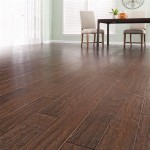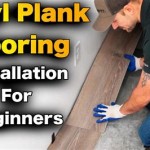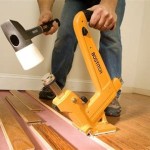Removing Linoleum Flooring from Concrete: A Comprehensive Guide
Removing linoleum flooring adhered to a concrete subfloor can be a challenging task, often requiring patience, the right tools, and a methodical approach. Linoleum, a resilient flooring option popular for its durability and affordability, is frequently installed using adhesives that create a strong bond with the concrete. This bond, while beneficial for the longevity of the flooring, also makes its removal a labor-intensive process. Understanding the various methods available and the potential issues that can arise is crucial for a successful removal project.
Before embarking on the removal process, it's vital to identify the type of adhesive used and the age of the linoleum. Older linoleum, particularly that installed before the 1980s, may contain asbestos. Asbestos is a hazardous material that requires professional abatement. If there is any suspicion of asbestos content, testing by a certified professional is mandatory before any disturbance of the flooring. Ignoring this precaution can lead to serious health risks.
Once it's confirmed that the linoleum is asbestos-free, the removal process can commence. The chosen method will depend on several factors, including the size of the area, the type of adhesive, and the condition of the concrete subfloor. Some methods are more aggressive and may increase the risk of damage to the concrete, while others are gentler but may require more time and effort.
Assessing and Preparing the Work Area
Prior to any physical work, a thorough assessment of the work area is essential. This involves inspecting the linoleum for any loose areas or seams that can be exploited during the removal process. Identifying areas where the adhesive bond is weaker can provide a starting point for prying up the flooring. Pay close attention to the perimeter of the room and any areas where the linoleum is damaged or peeling.
Preparation also involves protecting the surrounding area. Dust and debris generated during the removal process can spread easily, so covering adjacent surfaces with plastic sheeting is recommended. This includes walls, furniture, and any other items that cannot be easily moved out of the room. Using painter's tape to secure the plastic sheeting will prevent it from shifting during the work.
Personal protective equipment (PPE) is paramount. Safety glasses are necessary to protect the eyes from flying debris. Work gloves will protect the hands from abrasions and potential contact with adhesive residue. A dust mask or respirator is recommended to avoid inhaling dust particles, especially if mechanical methods are used. Ear protection may also be necessary if using power tools like a floor scraper.
Ventilation is another crucial aspect of preparation. Opening windows and doors will help to circulate air and reduce the concentration of dust and fumes. If natural ventilation is insufficient, using a fan to exhaust air from the room is recommended. This is particularly important when using chemical solvents to soften the adhesive.
Methods for Removing Linoleum Flooring
Several methods can be employed to remove linoleum flooring from concrete, each with its own advantages and disadvantages. The choice of method will depend on the specific circumstances of the project.
Manual Scraping: This method involves using a floor scraper to manually lift the linoleum from the concrete. It is a relatively low-cost option that requires minimal equipment. A long-handled floor scraper provides leverage and reduces the need to bend over, minimizing strain on the back. Start by scoring the linoleum into smaller sections using a utility knife. This makes it easier to lift and prevents large pieces from tearing, which can leave behind more adhesive residue. Work the scraper under the linoleum, applying consistent pressure to separate it from the concrete. This method is best suited for smaller areas or when the adhesive bond is relatively weak.
Heat Gun or Hair Dryer: Applying heat to the linoleum softens the adhesive, making it easier to scrape away. A heat gun or hair dryer can be used to warm the linoleum, but caution is necessary to avoid overheating the material or the adhesive. Work in small sections, heating the linoleum for a few seconds before attempting to lift it with a scraper. Keep the heat gun moving to prevent scorching or damaging the concrete. This method works well for stubborn areas or when the adhesive is particularly strong. Proper ventilation is crucial when using heat, as it can release fumes from the adhesive.
Chemical Solvents: Chemical solvents designed to dissolve or soften adhesives can be effective in removing linoleum. These solvents typically contain chemicals like adhesive removers. Apply the solvent according to the manufacturer's instructions, ensuring adequate ventilation. Allow the solvent to dwell for the recommended time before attempting to scrape away the linoleum. Test the solvent in an inconspicuous area first to ensure it does not damage the concrete. Be aware that chemical solvents can be flammable and should be handled with care. Wear appropriate PPE, including gloves and eye protection, when using these products. Disposal of used solvents must comply with local regulations.
Floor Scraper (Mechanical): A mechanical floor scraper is a power tool designed to remove flooring materials quickly and efficiently. These machines come in various sizes and configurations, and they can significantly reduce the labor involved in removing linoleum. However, they also require careful operation to avoid damaging the concrete subfloor. Select the appropriate blade for the job and adjust the angle of the blade to minimize the risk of gouging the concrete. Start in a small area to get a feel for the machine and adjust the settings as needed. Use caution when operating the machine near walls or other obstructions. Always wear ear protection and a respirator when using a mechanical floor scraper.
Addressing Adhesive Residue and Concrete Preparation
After the linoleum has been removed, adhesive residue is likely to remain on the concrete surface. Removing this residue is essential for preparing the floor for new flooring or other finishes. Several methods can be used to remove adhesive residue, depending on the type of adhesive and the condition of the concrete.
Scraping: A hand scraper or floor scraper can be used to remove loose or softened adhesive residue. This method is most effective when the residue is not firmly bonded to the concrete. Use a sharp blade and apply consistent pressure to scrape away the residue. Be careful not to gouge the concrete in the process.
Chemical Solvents: Applying chemical solvents specifically designed to dissolve adhesive residue is a common method. These solvents can soften the residue, making it easier to scrape away. Follow the manufacturer's instructions for application and dwell time. Ensure adequate ventilation when using chemical solvents and wear appropriate PPE. Rinse the concrete thoroughly after removing the residue to remove any remaining solvent.
Grinding: A concrete grinder can be used to remove stubborn adhesive residue and smooth the concrete surface. This method is more aggressive than scraping or using chemical solvents and should be used with caution to avoid damaging the concrete. Use a diamond grinding wheel with the appropriate grit for the job. Start with a coarser grit to remove the bulk of the residue and then switch to a finer grit to smooth the surface. Wear a respirator and eye protection when grinding concrete, as it generates a significant amount of dust. A dust collection system connected to the grinder can help to minimize dust exposure.
Concrete Restoration: In some cases, the removal process may damage the concrete surface, requiring restoration. This may involve patching cracks or holes with a concrete patching compound. Follow the manufacturer's instructions for mixing and applying the patching compound. Allow the compound to cure completely before proceeding with any further flooring installation. Significant concrete damage may necessitate professional concrete repair or resurfacing.
After removing the adhesive residue, thoroughly clean the concrete surface to remove any remaining dust and debris. Vacuum the floor and then wipe it down with a damp cloth. Allow the concrete to dry completely before installing new flooring. Inspect the concrete for any signs of moisture and address any moisture issues before proceeding. A moisture meter can be used to measure the moisture content of the concrete. High moisture levels can prevent proper adhesion of new flooring and lead to mold growth.
Proper preparation of the concrete subfloor is essential for a successful flooring installation. A clean, smooth, and dry concrete surface will ensure that the new flooring adheres properly and provides a long-lasting, durable finish.

How To Diy Easy Way Remove Linoleum Flooring Off Concrete Slab

This Is The Easiest Way To Remove Linoleum Glue From Concrete Hometalk

How To Easily Remove Linoleum Houseful Of Handmade

How To Finish Removing Linoleum Adhesive For Tile On Concrete Floor Hometalk

How To Diy Easy Way Remove Linoleum Flooring Off Concrete Slab

Diy Vinyl Or Linoleum Flooring Removal Dumpsters Com

How To Diy Easy Way Remove Linoleum Flooring Off Concrete Slab

What You Should Know About Removing Old Linoleum Or Vinyl Flooring Hq Longwood Fl

The Easiest Way To Remove Linoleum From Concrete

How To Remove Linoleum 13 Steps With S Wikihow
Related Posts








